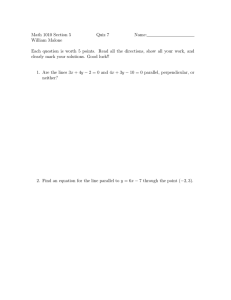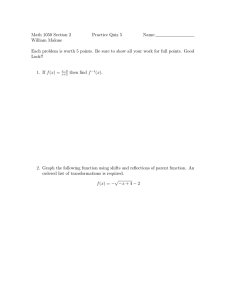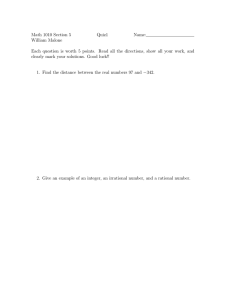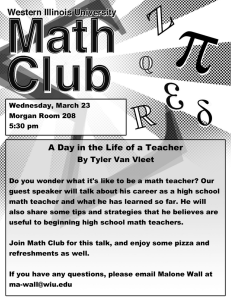Course wrap-up 15.320 Strategic Organizational Design
advertisement
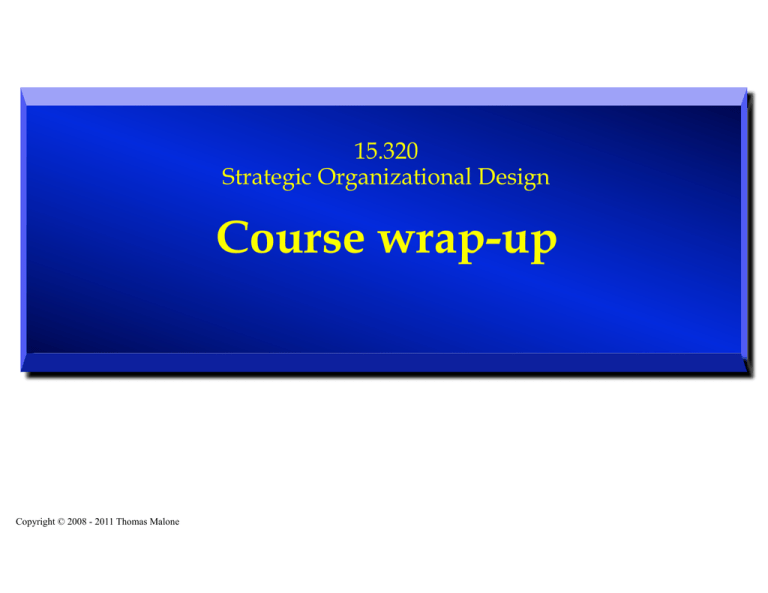
15.320 Strategic Organizational Design Course wrap-up Copyright © 2008 - 2011 Thomas Malone Two key messages • There are patterns in organizational design. • Organizational design is changing. There are patterns in organizational design • If you learn the common patterns, you don t need to keep rediscovering them. • If you apply these patterns well, your company can gain significant strategic advantage. Elements of organizational patterns Strategy What Staffing Who When Why Incentives (Alignment) How Structure (Grouping) Process (Linking) Copyright © 2008 Thomas Malone How can activities be grouped? Functional Organization Geographical Organization CEO Engineering Marketing CEO Manufacturing Product Organization Eastern US Western US Canada Matrix Organization CEO CEO Marketing Product 1 Product 2 Product 3 Copyright © 2007 Thomas Malone. Adapted from David Nadler & Michael Tushman, Strategic Organization Design (Glenview, IL: Scott Foresman, 1988), p. 68; and Richard L. Daft, Essentials of Organization Theory & Design (Cincinatti, OH: South-Western), 2001, p. 41. Product 1 Product 2 Manufacturing When are different groupings useful? Structure Strengths • Economies of scale within functional departments • In-depth knowledge and skill development Functional • Enables organization to accomplish functional goals • Best with only one or a few products Divisional (Product, Geography, Customer, Market) • Suited to fast change and innovation in unstable environment • Higher client satisfaction because product responsibility and contact points are clear • Units can adapt to differences in products, regions, clients • Decentralizes decision-making Matrix Weaknesses • Slow response time to environmental changes. Less innovation • May cause decisions to pile on top, hierarchy overload • Poor horizontal coordination among departments • Restricted view of organizational goals • Eliminates economies of scale in functional departments • Duplication of resources and poor coordination across divisions • Less in-depth competence and technical specialization • Integration and standardization across divisions (products, regions, etc.) more difficult • Achieves coordination to meet dual demands • Dual authority can be frustrating and confusing • Flexible sharing of human resources across divisions • Participants need good interpersonal skills and extensive training • Suited to complex decisions and rapidly changing environments • Opportunity for both functional and divisional skill development • Time-consuming: frequent meetings and conflict resolution sessions • Requires great effort to maintain power balance Copyright © 2007 Thomas Malone. Adapted from Robert Duncan, What is the right organizational structure? Decision tree analysis provides the answer, Organizational Dynamics (Winter 1979), p. 429; and Richard L. Daft, Essentials of Organization Theory & Design (Cincinatti, OH: South-Western), 2001, pp. 42-47. How can groups be linked? (lateral coordination processes) High In order of coordination capability (and management time and difficulty) Matrix organization Integrator (full-time) Formal groups (part-time, simple to complex) Formal electronic systems (e.g., CAD, CRM) Low Informal communication (e.g., voluntary conversations, informal groups) Copyright © 2007 Thomas Malone. Adapted from Jay R. Galbraith, Designing Organizations (San Francisco: Jossey-Bass), 2002, p. 46. Examples • Proctor & Gamble (history) • Google • Cisco • AES • Siemens How can groups be linked across organizations? (outsourcing) High Flexibility need Short-term contract Long-term contract Joint development / Alliance Partial ownership / Joint venture Full ownership Low High Control need Low Copyright © 2007 Thomas Malone. Adapted from James Brian Quinn & Frederick G. Hilmer, Strategic Outsourcing , Sloan Management Review, Summer 1994, pp. 43-55. When is outsourcing useful? Structure Strengths • Can take advantage of supplier’s specialization: – Economies of scale – In-depth knowledge and skill – Entrepreneurial motivation to excel on specialized task • Lower capital investment required • Many risks transferred to supplier Outsourcing – e.g., costs of development, weather, inventory, labor • More flexibility – Can change components or suppliers more easily (e.g., in rapidly changing technologies or fashion goods) – Can decrease design cycle times Weaknesses • Foregone profit on outsourced activities • Loss of critical skills internally – May make future developments harder • Coordination may be more difficult (and expensive) across firm boundaries • Loss of control – Supplier not necessarily motivated to take actions that are desirable for buyer – Supplier may be unwilling to make investments specific to a particular buyer – Supplier may “hold up” buyer later – Supplier may provide critical advantage to buyer’s competitors – Supplier may directly compete with buyer – Can draw on much larger pool of potential innovations Copyright © 2007 Thomas Malone. Based, in part, on: James Brian Quinn & Frederick G. Hilmer, Strategic Outsourcing , Sloan Management Review, Summer 1994, pp. 43-55; Thomas W. Malone, The Future of Work, Boston: Harvard Business School Press, 2004, pp. 104-108. Examples • Proctor & Gamble (Connect & Develop) • eBay • InnoCentive • Wikipedia • Threadless • … Eight steps for organizational change 1. Establish a sense of urgency Identify potential crises or major opportunities. 5. Empower others to act on vision Remove obstacles (individual & organizational). 2. Form a powerful coalition Assemble a group with enough power to lead change effort. 6. Create short-term wins Systematically plan for (and celebrate) early victories. 3. Create a vision Compelling, can be communicated in less than 5 minutes 7. Consolidate and spread improvements Don t declare victory too soon. Keep spreading change. 4. Communicate the vision Communicate (by words and examples) ten times more than you think you need. 8. Institutionalize new approaches Connect change to organizational culture and succession. Adapted from John P. Kotter, Leading Change: Why Transformation Efforts Fail, , Harvard Business Review, January 2007, pp. 96-103. Keys to organizational change (condensed version) • Support from the powerful • Participation of those affected • Phased approach Examples • Charlotte Beers at Ogilvy & Mather • iStockPhoto, Current TV • … Organizational design is changing • New, often more decentralized, patterns are becoming increasingly desirable. • You will probably have opportunities in your career to invent or apply new organizational design patterns. How technology enables changes in organizational design Cheap transportation More tasks can be done anywhere in the world. More innovation New ideas travel faster. Change is faster. Innovation is more important. New technologies Cheap communication More globalization People are more innovative when making decisions for themselves. More freedom More people can have more information and make more decisions for themselves. Less need for people to do physical work. Cheap automation For other physical and information tasks Shaded boxes indicate core argument in Malone, Future of Work More knowledge work More education More affluence People are more able to do knowledge work. Basic needs are already met. People are better at knowledge work when making decisions for themselves. Intangible needs are more important In other words… • New technologies (for communication, transportation, and automation) • are decreasing the costs and increasing the desirability of • organizations where – more people make more decisions (freedom) – activities are more distributed geographically (globalization) – intangible needs are more important What new types of organizational genes are becoming more common? Create Decide What Crowd Hierarchy q Money Who Why q Glory q Love How Crowd Independent Dependent Create Collection Collaboration Decide Individual decisions Group decision When is the Crowd gene useful? • The resources useful in solving the problem are distributed widely (or in unknown places). • The problem be divided into pieces such that: – Single individuals can do the pieces. – Enough individuals can be found and are (or can be) sufficiently motivated to participate. – The current owners of necessary information are willing to share it with the crowd. – Gaming and sabotage can be managed satisfactorily. – … Copyright © 2009 Thomas Malone. Based, in part, on: Malone, T. W., Laubacher, R., & Dellarocas, C. The Collective Intelligence Genome, Sloan Management Review, Spring 2010, 51, 3, 21-31. How? Create Crowd Independent Dependent Collection Collaboration • Contest Decide Individual decisions Group decision • Voting • Market • Consensus • Social network • Prediction markets • Other How? Examples Crowd Create Independent Collection • YouTube videos • Wikipedia (collection) • InnoCentive Decide Individual decisions • iStockPhoto • eBay • Amazon recommendations Dependent Collaboration • Linux • Wikipedia (article) Group decision • Kasparov v. World • Prediction markets When is democratic voting desirable? Structure Favorable conditions • The knowledge, skills, and motivation needed to make a good decision are distributed widely.* • The average voter is more likely to make a good decision than a bad one.*** • Whoever controls the information needed to make good decisions is willing to share it with voters.* Democratic voting • Everyone in the group needs to abide by the same decision. (Otherwise individuals can just decide for themselves without a group vote.)** • It is important for the voters to be committed to the decision. (They are more likely to feel committed to the decision if they had a chance to vote on it.) Unfavorable conditions • The average voter is more likely to make a bad decision than a good one.*** • The voters motivations are too divergent. For instance, there is no satisfactory way to prevent: • Gaming* • Sabotage* • There isn t enough time (or enough of other resources) for everyone to become informed and then to vote. • If votes are visible to others, then • early voters may have too much influence on decisions ( information cascades ) • social pressures may have too much influence on decisions * Conditions shared with other forms of action by a Crowd ** Conditions shared with other forms of Group Decision *** See Condorcet Jury Theorem (described, for example, in Sunstein, 2006) Copyright © 2009 Thomas Malone. Based, in part, on: Malone, T. W., Laubacher, R., & Dellarocas, C. Harnessing Crowds: Mapping the Genome of Collective Intelligence. MIT Center for Collective Intelligence Working Paper, January 2009; and Sunstein, C. R. Infotopia, New York: Oxford University Press, 2006, ch. 2, 3. When are internal markets desirable? Structure Internal Markets Strengths • Efficiency Maximizing your own benefits, results in efficient overall allocation (the invisible hand) • Flexibility More information and minds applied to figuring out how to adjust Individual variation can be accommodated • Motivation People are often more motivated and creative when they are rewarded directly for the results of their own actions Weaknesses • Incentive problems Sometimes agreements that would be good overall aren’t in the individual interests of one or both parties involved. • Communication Lots of communication usually needed to find and compare alternatives and to negotiate agreements. Copyright © 2009 Thomas Malone. Based on Thomas W. Malone, The Future of Work, Boston: Harvard Business School Press, 2004, pp. 104-108. When are all the different Crowd genes useful? Copyright © 2009 Thomas Malone. Based, in part, on: Malone, T. W., Laubacher, R., & Dellarocas, C. The Collective Intelligence Genome, Sloan Management Review, Spring 2010, 51, 3, 21-31. . Evocative examples of Crowd genes • InnoCentive • Intel scenario • eBay • Threadless • Wikipedia • Cambrian House • W. L. Gore • iStockPhoto • … For what purposes are we designing organizations? • Values that are not easily measured in economic terms are often important to many key stakeholders in organizations: investors, customers, workers, and others. • IT makes an organization s actions about these values more visible to the world. • Therefore: • You have more opportunities to pursue non-economic values if you want to. • You have to care more about your stakeholders noneconomic values, whether you want to or not. Examples where non-economic values are critical • Wikipedia • AES • Threadless • Whole Foods • … What does this mean for your career? • If you know how to recognize and apply classic patterns of organizational design, you ll be better able to implement strategies effectively in many situations. • If you know how to effectively invent or apply innovative organizational designs, you may be able to make this a key element of your whole strategy. What does this mean for your life? • You probably have more choices than you realize. • To make the choices wisely, you need to think about what really matters to you. How can you know what to do? • … What can I actually do? The answer is as simple as it is disconcerting: we can, each of us, work to put our own inner house in order. The guidance we need for this work cannot be found in science or technology, . . . but it can still be found in the traditional wisdom of mankind. – E. F. Schumacher, Small Is Beautiful, 1973 MIT OpenCourseWare http://ocw.mit.edu 15.320 Strategic Organizational Design Spring 2011 For information about citing these materials or our Terms of Use, visit: http://ocw.mit.edu/terms.

